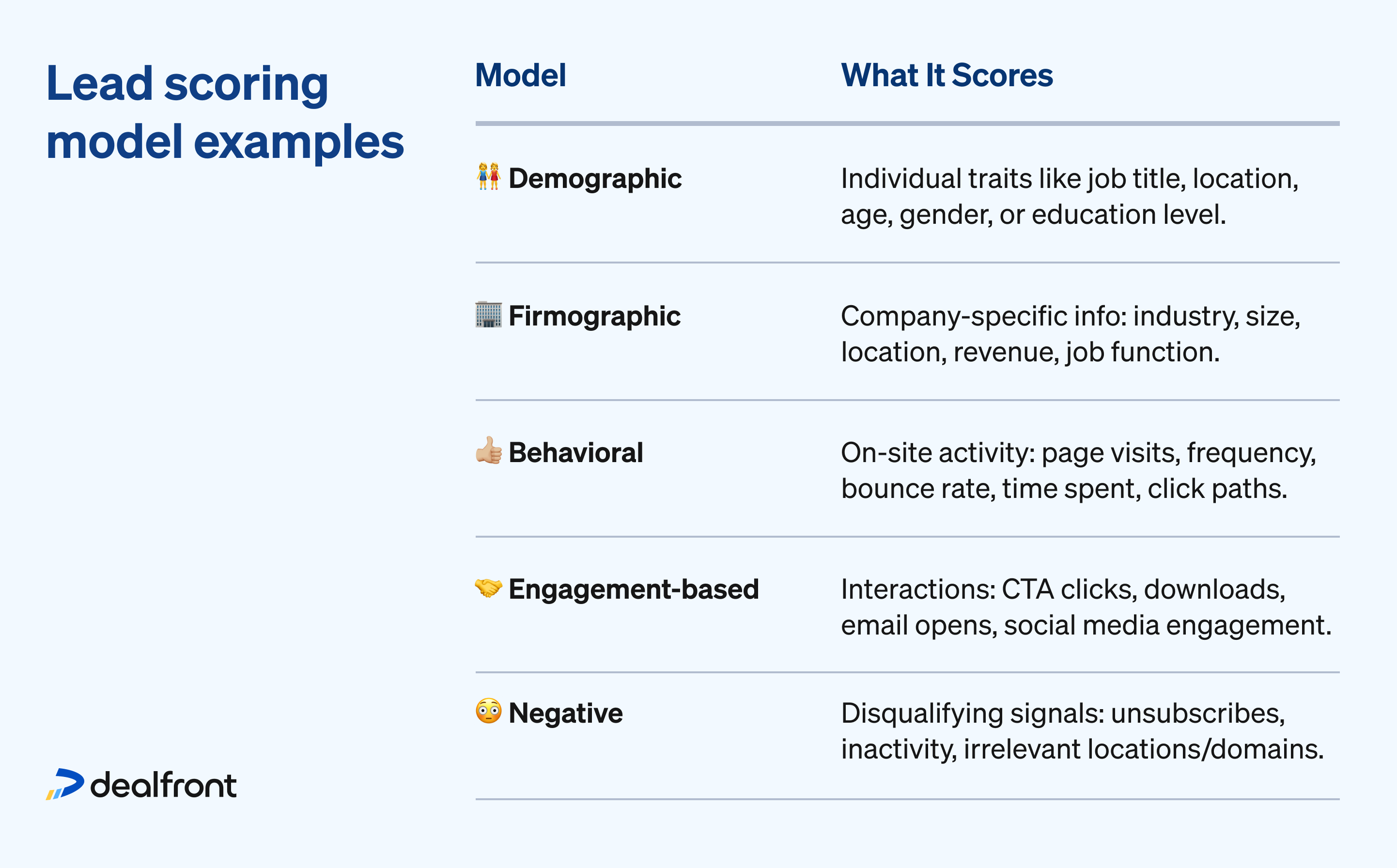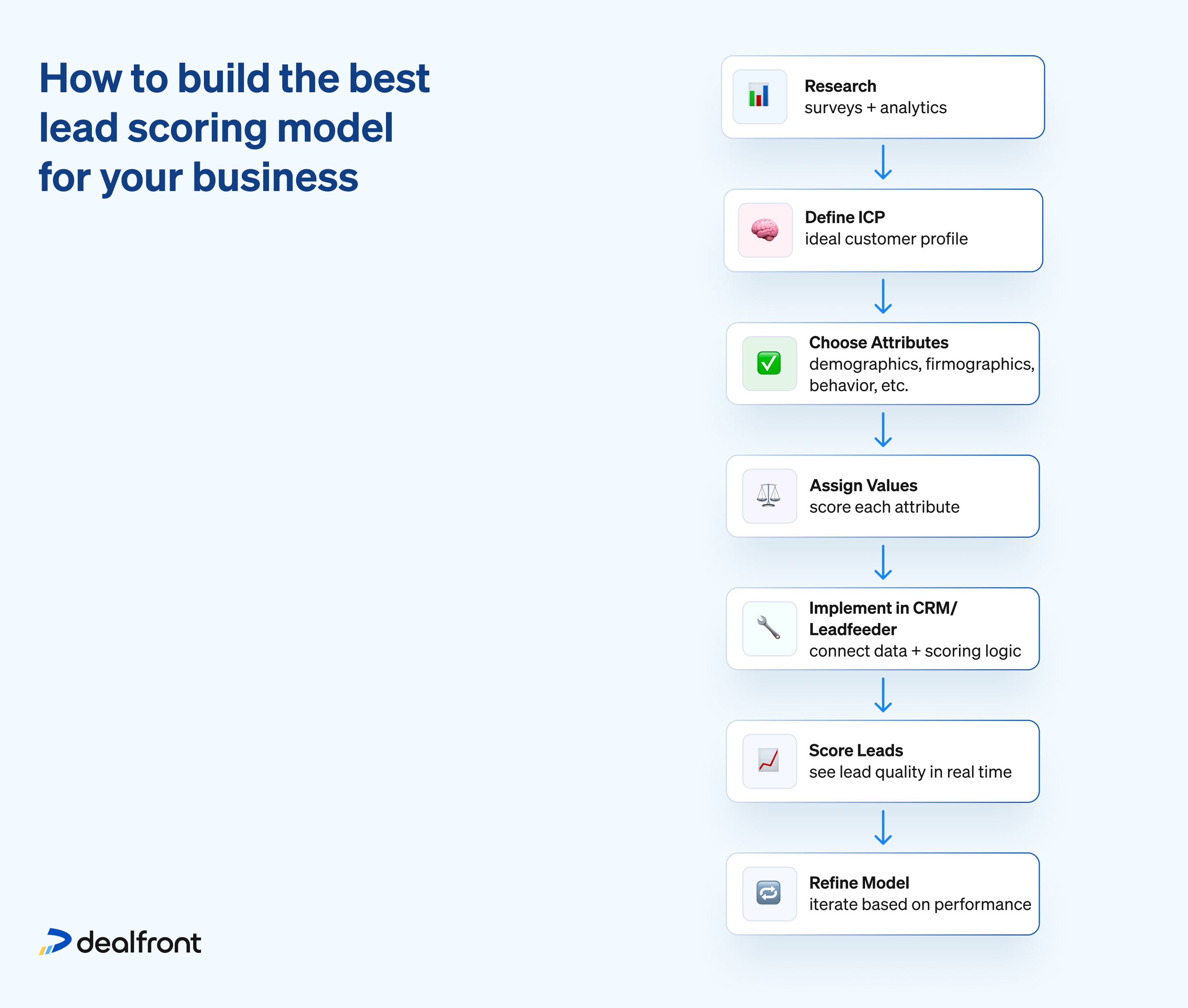The problem is, you get to the lead that��’s third or fourth in line, and, yep, they’ve gone. This is because a lead isn’t a lead forever.
You need to find a way to get this situation in some proper order so that you don’t waste time on possibly unproductive leads and instead zero in on the ones that are going to give results. You need lead scoring.
Let’s talk about how lead scoring works and the benefits it can bring, before seeing how you can get it to work for your business.
What is lead scoring?
Lead scoring is a way of prioritizing leads. That’s it. OK, there’s more to it, which we’ll get into, but the main premise is precisely that clear and straightforward.
What’s the priority based on? The lead’s likelihood of buying from you. This is usually represented by a score of 1 to 100.
There are several different types of lead scoring, which are called lead scoring models.
What is a lead scoring model?
A lead scoring model is the system or framework businesses use for their lead scoring. These models can take several different forms, and we’ll review the main ones a little later.
One important thing to know about lead scoring models is that they concentrate on quite different aspects of the customer. Another is that you can combine more than one model if that best suits your business needs.
Why is lead scoring important?
There are many reasons why it’s important to prioritize leads. Let’s run through the main ones:
1. It optimizes resources
Because you and your sales team don’t have unlimited resources, you need assistance with knowing where to deploy them.
It makes sense for the most promising leads to attract your immediate attention. You can then go to work on them, get the conversion, and move to the next on your list.
This might mean that you turn to the lead that’s been waiting in the queue, with the next highest potential. Or, it could mean that you turn to a lead that’s only just come in, and that’s leapfrogged to the front of the line because it’s been scored highest.
The point with lead scoring is that you maximize your effectiveness by removing from your work pile those business leads that are less likely to deliver. You can downgrade those ones until time or staffing allows.
2. Gives foundation for follow-up
When the conversion is achieved, you don’t usually want it to end there. There are follow-up communications to be sent concerning service arrangements, product support, and, in time, upscaling options.
Good lead scoring data will help your follow-up team decide where best to deploy their efforts.
In other words, a high-scoring lead is not just good news for initial conversions. It can also mean fruitful territory for further interaction, giving better customer lifetime value.
3. Better personalization
Customers tend to love personalization. It’s great to feel special and that your individual needs are being catered to.
A lead score model will help with this because personalization is based more than anything else on the information you have about a prospect.
Without data concerning that customer, a personalized experience is impossible. A huge range of data, from customer name and job title to buying history, can make all the difference to your personalization efforts, and lead scoring also involves collecting and analyzing these data varieties.
Lead scoring model examples
So, now let’s turn to the different kinds of lead scoring model template you can deploy.
Demographic-based model
This is a lead scoring model that uses information about an individual customer, such as job title, age, education level, gender, and location.
The premise here is that such characteristics are considered hugely significant in how an individual will approach certain developments.
They may inform their interests, their priorities, and their attitude to risk and commitment. These kinds of conclusions can be highly influential on an individual’s decision whether or not to buy.
Firmographic-based model
This lead score model is all about information to do with the company that the customer works within. So, the job title is in there, as well as the kind of industry we’re talking about, plus the location, size, and revenue of that company.
Here, the b2b lead scoring model is looking at what a company engaged in a particular business is going to be interested in.
Moreover, this model factors into consideration what outgoings the company is likely to be capable of. If the business is probably going to be keen but is unfortunately too small to be able to invest in what you’re offering, then this should inform the lead score.
Where can you find this kind of information? You could try Dealfront’s Datacare. It gives you the means to maintain accurate and clean data on a multiplicity of businesses.
Behavioral-based model
The above two lead scoring models were examples of what are known as explicit models. They tell us a lot about who the lead is. The lead score model we’re looking at now is an example of an implicit model. Here, we’re looking at what the lead does.
This kind of model falls onto the latter side of the interest or intent-based lead scoring debate. It assesses how a customer interacts with your site. How often do they visit? What do they do when they’re there? Do they go to the pricing page or do they bounce straight off from the landing page?
All these factors can tell you a huge amount about the lead’s intent and enable you to decide whether this lead means business or is merely passing through.
Engagement-based model
This is another implicit lead scoring model looking at behavior, but behavior of a specific kind.
Your site will offer several ways for a customer to engage with it, and it’s this aspect that’s key here. (If your site doesn’t offer this, maybe you should go and take a look at it—you may be missing out on a key deliverable.)
This engagement might involve the customer clicking on one of your CTAs. This would be a clear indication of commitment to what you’re offering. Or, it might include them downloading some product information from your site or emailing the contact address. Or, perhaps they get involved with your social media posts.
Whichever engagement path they choose, this model scores that move so that you know immediately who seems most interested in you.
Check out our Playbook on how to engage with open opportunities that are visiting your website to ensure you’re making the most of the prospects that are engaging with you.
Negative lead scoring model
All the lead scoring models we’ve discussed so far have shared a positive scoring approach. By this, we mean that if something looks likely to increase a prospect’s appeal, they’ll get a point added to their score. In this last model, however, we’re looking at the other side of the coin.
Particular traits or behaviors indicate a drop in the likelihood of converting. These can include really obvious ones, like unsubscribing or engagement dropping to zero for a prolonged period. Customers exhibiting these behaviors will be negatively scored.
As well as these top line behaviors, there are other factors that might attract a negative score. A generic rather than business-specific email address, for example. Or an IP address that indicates that the customer is geographically situated outside your business’s target area.
What you do as a result may vary, depending on your policy and resources. You may wish to offer a re-engagement incentive, for instance. Or you may decide that you’ll have to eliminate these leads from your activity, as they’re just not very enticing. Hey, you can’t win them all. And at least this way, you end up with more time to devote to the promising ones.
How to build the best lead scoring model for your business
You may be thinking to yourself that all you need to know now is how to create a lead scoring model that’ll work for your business. Here’s how:
1. Do your research
The first step towards great b2b lead scoring models is to understand your customer. And you don’t do this in a vacuum. You’re going to need some expert opinion here, so bring in your sales and marketing teams and listen to their observations.
Don’t forget to consult those with the most expertise of all: Your customers. By engaging with them on what makes them tick you’ll find out a lot more than by just observing them. So, conduct some surveys to establish some background factors behind your customers. You may find that certain constants emerge.
And here’s a bonus: Surveys can also be effective promotional tools. You can include all kinds of product mentions while digging into your subjects’ backgrounds.
You can then combine this research with some sturdy analytics of information on customer behavior and intent data.
Once you know your target customer, you’ll be better able to determine what characteristics you’re looking for in a lead. This leads us to the next point.
2. Choose the attributes to score & assign values
So, you’ve got your ideal customer profile. Now it’s time to transfer the key characteristics to your lead scoring model.
Age and gender could be major considerations. For example, a new donut line that’s tied into Disney’s latest cartoon is not necessarily going to win over many customers in the senior bracket.
In another example, your data might make it pretty clear that, for one reason or another, your B2B service seems to be more of a winner with women than men. In that case, you may decide that female leads should score higher than male ones.
This is just using data from the demographic model, of course. Let’s look at the firmographic approach. Sometimes, the business an individual works for can be more significant in terms of conversion likelihood than any personal factors.
For instance, your sales intelligence may tell you that there’s going to be a bit of a boom in domestic goods, the kinds of products that sell particularly well remotely. You happen to sell contact center solutions that can scale a business operation up to meet the highest demands. However, this gear comes at a cost.
Firmographic information will tell you whether your lead is in the right area of activity and, crucially, what their company is likely to be able to afford. If things look good, they get a good lead score. Such data will soon focus your efforts on the most productive leads.
3. Decide if one score is enough
You can use more than one lead scoring model template simultaneously if you like.
Sometimes, this tandem approach yields more information about what you’re looking for in a lead.
Remember that we’re none of us entirely reducible to a set of demographic factors. There’s so much more to us than just our age and gender. Similarly, concentrating solely on what a person does online will only tell you a certain amount about that person. It’ll tell you what they click on, but won’t always tell you why.
If you’re able to add in some firmographic data that tells you that the individual has clicked on the CTA because their business appears to be expanding, that could make a big difference. All of a sudden, you’re beginning to understand motivation, a key part of putting yourself in the shoes of that customer.
So, it might be the case that combining one score with another will give you the rounded picture you need in your lead management.
Lead scoring best practices
Let’s finish by looking at some best practice tips that will help you ensure that your lead scoring model’s implementation goes as smoothly as possible:
Define a threshold when a lead becomes sales-qualified
The thing with empirical scores is that they gain value only when there’s a threshold applied. By this, we mean you have to decide at what point a lead score tells you that this lead is to be prioritized and sent down the funnel to the next stage.
Set the score too low, and you may be swamped with leads of varying quality. This tends to defeat the object of lead scoring in the first place.
Set the score too high and you only ever get the creme de la creme of leads. Sounds great, but the trouble is that you may go for months before you actually get one that measures up, even if you go all out to boost lead generation.
So, be realistic. You want to have a manageable rate of good-quality leads coming through.
A good idea is to run a simulation with past data. This can show you the kind of rate of delivery that you can then expect to come through once you start for real. You can then decide if it’s too low, too high, or just right. Goldilocks eat your heart out.
If you’re going to end up with numerous leads coming through that you’ll struggle to accommodate, then you may use this information to justify investment in your sales team to give you better capacity. After all, it would be a shame to wave those possibilities goodbye.
Use the right tools to streamline lead scoring
Are you thinking that this all sounds great but might be a bit too much for you to handle right now?
Happily, there are some great tools out there that can help you get your lead scoring model off the ground and delivering great quality leads in no time.
Use Leadfeeder by Dealfront, for instance, to manage your lead scoring and you’ll get loads of the work done with no effort from you. Companies that you’ve targeted as especially of interest to you (because of their area of activity, position in the industry, or alignment with your ICP) can be automatically tracked and scored for you, with insights served at a frequency you can decide.
Other data, such as behavioral insights into how long customers spend on your site, are all available for use and can combine with a multitude of other factors to keep your lead operation healthy and productive.
Dealfront also combines well with what you may have in your existing tech stack, integrating effortlessly with Salesforce, Zoho, Hubspot, and other CRM platforms.
Continually iterate and improve
Lead scoring is never 100% complete. It’s an ever-evolving tool that changes as the world changes.
For instance, there may be those who decide to buy from you who are outside your existing ideal customer profile. This might be an aberration, or it might represent a trend that you need to factor into your target customer construct.
You then need to decide on the emphasis you should put on these new characteristics when it comes to lead scoring.
What will eventuate is a series of re-iterations of lead scores, so that your lead score model stays as current and as relevant as it needs to.
Dealfront can help support any lead scoring system
So, we’ve learned that you have a good choice of lead scoring models and that you can combine them to give a good fit for your business needs.
The great news is that Dealfront has the tools to support you no matter which lead scoring model (or models) you opt for.
Using solutions such as Leadfeeder to manage your lead scoring and Datacare to assist with the quality of data you’ll need, you’ll be ready to start enjoying the benefits of lead scoring in short order.
All too often, when you find out about a game-changing technique, it comes with lots of work needing to be done. It’s not often that you get to learn about one at the same time as discovering a totally trouble-free way of implementing it. You’re welcome.


